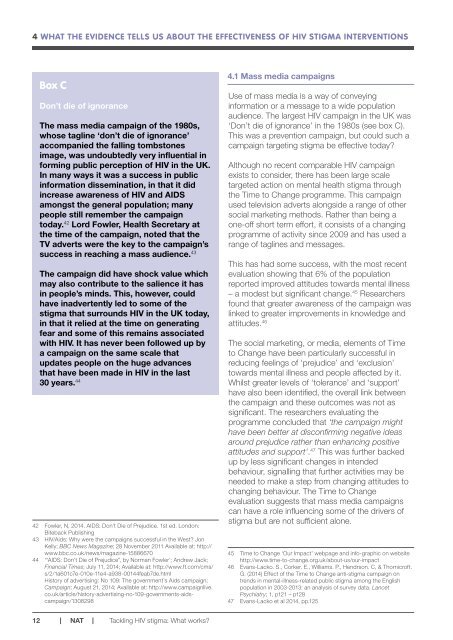Tackling HIV Stigma What works?
Jun_16_Tackling_HIV_Stigma
Jun_16_Tackling_HIV_Stigma
You also want an ePaper? Increase the reach of your titles
YUMPU automatically turns print PDFs into web optimized ePapers that Google loves.
4 WHAT THE EVIDENCE TELLS US ABOUT THE EFFECTIVENESS OF <strong>HIV</strong> STIGMA INTERVENTIONS<br />
4.1 Mass media campaigns<br />
Box C<br />
Don’t die of ignorance<br />
The mass media campaign of the 1980s,<br />
whose tagline ‘don’t die of ignorance’<br />
accompanied the falling tombstones<br />
image, was undoubtedly very influential in<br />
forming public perception of <strong>HIV</strong> in the UK.<br />
In many ways it was a success in public<br />
information dissemination, in that it did<br />
increase awareness of <strong>HIV</strong> and AIDS<br />
amongst the general population; many<br />
people still remember the campaign<br />
today. 42 Lord Fowler, Health Secretary at<br />
the time of the campaign, noted that the<br />
TV adverts were the key to the campaign’s<br />
success in reaching a mass audience. 43<br />
The campaign did have shock value which<br />
may also contribute to the salience it has<br />
in people’s minds. This, however, could<br />
have inadvertently led to some of the<br />
stigma that surrounds <strong>HIV</strong> in the UK today,<br />
in that it relied at the time on generating<br />
fear and some of this remains associated<br />
with <strong>HIV</strong>. It has never been followed up by<br />
a campaign on the same scale that<br />
updates people on the huge advances<br />
that have been made in <strong>HIV</strong> in the last<br />
30 years. 44<br />
42 Fowler, N, 2014. AIDS: Don’t Die of Prejudice. 1st ed. London:<br />
Biteback Publishing<br />
43 <strong>HIV</strong>/Aids: Why were the campaigns successful in the West? Jon<br />
Kelly; BBC News Magazine; 28 November 2011 Available at: http://<br />
www.bbc.co.uk/news/magazine-15886670<br />
44 ‘“AIDS: Don’t Die of Prejudice”, by Norman Fowler’; Andrew Jack;<br />
Financial Times; July 11, 2014; Available at: http://www.ft.com/cms/<br />
s/2/1a601c7e-010e-11e4-a938-00144feab7de.html<br />
History of advertising: No 109: The government’s Aids campaign;<br />
Campaign; August 21, 2014; Available at: http://www.campaignlive.<br />
co.uk/article/history-advertising-no-109-governments-aidscampaign/1308298<br />
Use of mass media is a way of conveying<br />
information or a message to a wide population<br />
audience. The largest <strong>HIV</strong> campaign in the UK was<br />
‘Don’t die of ignorance’ in the 1980s (see box C).<br />
This was a prevention campaign, but could such a<br />
campaign targeting stigma be effective today?<br />
Although no recent comparable <strong>HIV</strong> campaign<br />
exists to consider, there has been large scale<br />
targeted action on mental health stigma through<br />
the Time to Change programme. This campaign<br />
used television adverts alongside a range of other<br />
social marketing methods. Rather than being a<br />
one-off short term effort, it consists of a changing<br />
programme of activity since 2009 and has used a<br />
range of taglines and messages.<br />
This has had some success, with the most recent<br />
evaluation showing that 6% of the population<br />
reported improved attitudes towards mental illness<br />
– a modest but significant change. 45 Researchers<br />
found that greater awareness of the campaign was<br />
linked to greater improvements in knowledge and<br />
attitudes. 46<br />
The social marketing, or media, elements of Time<br />
to Change have been particularly successful in<br />
reducing feelings of ‘prejudice’ and ‘exclusion’<br />
towards mental illness and people affected by it.<br />
Whilst greater levels of ‘tolerance’ and ‘support’<br />
have also been identified, the overall link between<br />
the campaign and these outcomes was not as<br />
significant. The researchers evaluating the<br />
programme concluded that ‘the campaign might<br />
have been better at disconfirming negative ideas<br />
around prejudice rather than enhancing positive<br />
attitudes and support’. 47 This was further backed<br />
up by less significant changes in intended<br />
behaviour, signalling that further activities may be<br />
needed to make a step from changing attitudes to<br />
changing behaviour. The Time to Change<br />
evaluation suggests that mass media campaigns<br />
can have a role influencing some of the drivers of<br />
stigma but are not sufficient alone.<br />
45 Time to Change ‘Our Impact’ webpage and info-graphic on website<br />
http://www.time-to-change.org.uk/about-us/our-impact<br />
46 Evans-Lacko. S., Corker. E., Williams. P., Hendrson. C, & Thornicroft.<br />
G. (2014) Effect of the Time to Change anti-stigma campaign on<br />
trends in mental-illness-related public stigma among the English<br />
population in 2003-2013: an analysis of survey data. Lancet<br />
Psychiatry; 1, p121 – p128<br />
47 Evans-Lacko et al 2014, pp.125<br />
12 NAT<br />
<strong>Tackling</strong> <strong>HIV</strong> stigma: <strong>What</strong> <strong>works</strong>?


